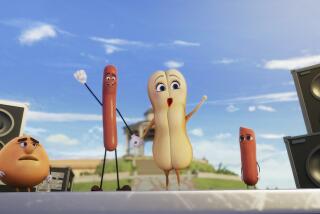‘Animal Farm’ an Adult Cartoon
- Share via
The Brits took a long time before turning to animation. When England’s movie industry finally did, in 1954, it wasn’t an anglicized take on the kind of family fare that did so well in the States--no pretty story about little deer, little elephants or little mice.
The inspiration for Britain’s first full-length cartoon was none other than George Orwell’s “Animal Farm,” the slim but telling book that gave many of us (like a lot of people, I had to read it in high school) our first metaphor on the dangers of fascism.
This 75-minute feature came with a built-in qualifier: “Animal Farm” (screening Friday as part of UC Irvine’s “Inside Outsiders” series) was not for children, at least not young ones. Take the kids to “Bambi” or “Dumbo” but leave them behind for this adaptation; they just wouldn’t get it.
The thing is, producers and directors John Halas and Joy Batchelor seemed torn by the project. The only way they could bring Orwell’s satire to the screen was through animation, but the language of cartoons (at least back then) was so specific that Orwell’s allegory might be trivialized. Cartoon animals are cute, no matter what the setting, and they often seem cute in the movie. They never seem cute in the book.
Call it the Disneyfication of a political tract. The feature, with its decent but idealized drawings of life down on the old totalitarian farm, doesn’t have the power of Orwell’s words. But it does have a different kind of persuasiveness--even when cartoon-corny, you react to the film on a basic emotional level.
Part of that comes from “Animal Farm’s” brutality, which is intermittent but relatively graphic. At first, these lovable farm animals are abused by Mr. Jones, drawn as a monstrous caricature of Hitler, and later by the pigs who rise to power once he’s been run off. It’s a little like watching Disney pals suffering through one painful experience after another.
The point of “Animal Farm,” as with the novel, is that preserving the ideals of revolution is hard work, and that we must be wary of the leaders we choose to help us out. Orwell underscored how language and guile can be employed to control the masses.
The feature is faithful to that, up to a point. Once Mr. Jones is deposed, the animals seem well on their way to achieving a righteous social order. Snowball, a visionary pig if ever there was one, has taken over for the benevolent and Churchillian Old Major and is forging a collective where everybody shares equally.
There’s a rat in paradise, though. The ruthless pig Napoleon wants to run things and, as a first step, turns a litter of abandoned puppies into his own guards, along the lines of a four-legged SS squad. After they dispose of Snowball, it’s all downhill.
Napoleon starts changing the workers’ commandments--”No Animal Shall Kill Another Animal” is replaced with “No Animal Shall Kill Another Animal Without Cause” and so forth--and institutes a regime more repressive than Mr. Jones’. By the time Boxer, the courageous and uncomplaining plow horse, is sold to the glue factory by Napoleon’s hench-pigs, we’re yearning to have these mean oinkers turned into bacon.
They are, of course, but through an uprising that reaches far beyond Animal Farm. Sheep, chickens, cows, you name it, descend on the homestead and restore the revolution for all. It’s a cartoon ending, far rosier than the pessimistic one Orwell gave us.
More to Read
Only good movies
Get the Indie Focus newsletter, Mark Olsen's weekly guide to the world of cinema.
You may occasionally receive promotional content from the Los Angeles Times.










